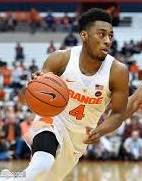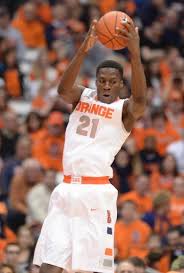Tyus Battle has announced he will be returning to Syracuse
for his junior season. As a result, the
Syracuse Orange will be returning their entire starting basketball lineup for
the 2018-2019 season. The Orange will suit up Battle, Frank Howard, Oshae Brissett, Marek Dolezaj, and Paschal Chukwu. This is a very rare
occurrence in Syracuse basketball history, having only occurred four previous
times.
In 1999-2000, the entire starting lineup from the previous
year returned, but Allen Griffin lost his starting position to Tony Bland, and
did not start a single game for the season. The 1998-1999 starting lineup was
Jason Hart, Allen Griffin, Damone Brown, Ryan Blackwell, and Etan Thomas. The squad would improve from 21-12 (10-8 Big
East) to 26-6 (13-3 Big East), and was the Big East regular season champion.
The team would be ranked as high as #4 in the country in early February, before
finishing the year at #16. They would lose
in the NCAA tournament to Michigan State in the Sweet Sixteen.
The 1982-1983 squad saw Gene Waldron, Erich Santifer, Tony
Bruin, Leo Rautins and Andre Hawkins all return from a 16-13 (7-7 Big East)
team. The previous season was one of the
least successful teams in Jim Boeheim history. The 1982-1983 squad saw an
improvement to 21-10 (9-7 Big East), including wins over #9 Houston, and #4
Villanova. The team would lose in the 2nd round of the NCAA to Ohio
State.
The 1933-1934 team returned Elmer Maister, Ronnie Phillips,
Lou Alkoff, Johnny DeYoung and Skids Sanford. The 1932-1933 team was an
impressive 14-2, and won their last 12 games of the season, including going undefeated
against the Eastern basketball teams.
The 1933-1934 team would go 15-2, one win better, but did lose to Eastern
foes Colgate (on the road) and Penn (on the road). The season was deemed very successful,
despite the 1932-1933 leading scorer Johnny DeYoung injuring his leg and
missing playing time as a result. They would conclude their season with a very
lopsided home win over Colgate.
 |
| Reindeer Five |
The 1930-1931 team returned the famed Reindeer Five squad of
Ev Katz, Dan Fogarty, Ken Beagle, Tuppy Hayman and Slim Elliott. The 1929-1930 team went 18-2 with big road
wins over Michigan State and Penn, and would go 15-1 against Eastern basketball
team. The team was known for its speed on the court, balanced scoring, and did
not have too many close games. The
1939-1931 team would drop to 16-4, still an impressive record. The highlight of the season was three
consecutive road wins against Penn State, Penn and Colgate.
It makes sense that starting lineups rarely return
intact. Most teams have at least one senior
in the starting lineup, which means graduation impacts the ability to return
the squad. Academic issues and transfers
also come into play. In the modern era, early departure to the NBA definitely
impacts the ability of a team to retain starters. The 2008-2009 squad has no seniors in the starting
lineup, but Paul Harris and Eric Devendorf both left school a year early to pursue
pro careers. Same thing with the 2007-2008
squad, as Donte’ Greene would leave after his freshman year. The 2003-2004 squad lost Billy Edelin to
academic issues mid-season, which prevented that squad from returning all its
starters.






